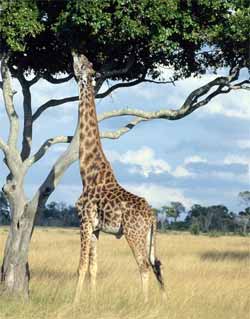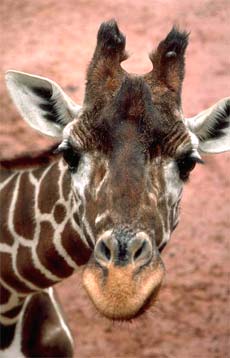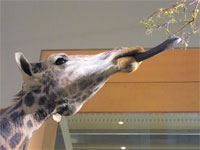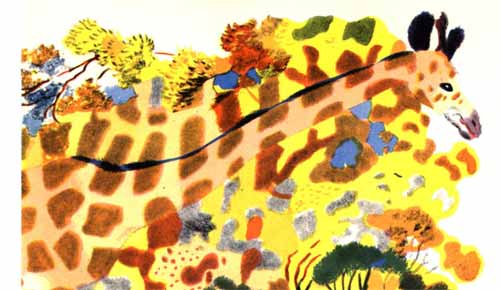
 Cow Cousin? The giraffe is related to deer and cattle, but is placed in a separate family, the Giraffidae, consisting only of the giraffe and its closest relative, the okapi. The instinct of some other African animals is to stay close to the giraffe, for the giraffe's high vantage point can see predators from far away. Cow Cousin? The giraffe is related to deer and cattle, but is placed in a separate family, the Giraffidae, consisting only of the giraffe and its closest relative, the okapi. The instinct of some other African animals is to stay close to the giraffe, for the giraffe's high vantage point can see predators from far away.
Spot the Giraffe!: Giraffes have spots covering their entire bodies, except their underbellies, with each giraffe having a unique pattern of spots. They have long, prehensile tongues that are distinctly blue. Giraffes have long necks, which they use to browse the leaves of trees. They also have slightly elongated forelegs, about 10% longer than their hind legs. Like nearly all mammals, a giraffe has seven neck vertebrae, which are extremely elongated. These bones produce bud-like horns called ossicorns.
 Neck Attack: It has been observed that males use their long necks not only for feeding, but also for combat and competition. Indeed, sexual dimorphism is strongly represented among giraffes, with females having shorter, lighter necks than males. Neck Attack: It has been observed that males use their long necks not only for feeding, but also for combat and competition. Indeed, sexual dimorphism is strongly represented among giraffes, with females having shorter, lighter necks than males.
A female's neck and head mass will level off after about ten years of age, while a male's will continue to increase throughout its twenty-plus years of life.
The males engage in necking combat. These battles can be fatal, but are more often less severe. The longer a neck is, and the heavier the head at the end of the neck, the greater force a giraffe will be able to deliver in a blow. It has also been observed that males that are successful in necking have greater access to estrous females, so that the length of the neck may be a product of sexual selection.
A Heart That Stands Apart: Modifications to the giraffe's structure have evolved, particularly to the circulatory system. A giraffe's heart, which can weigh up to 10 kg (24 lb), has to generate around double the normal blood pressure for a large mammal in order to maintain blood flow to the brain against gravity. In the upper neck, a complex pressure-regulation system called the rete mirabile prevents excess blood flow to the brain when the giraffe lowers its head to drink. Conversely, the blood vessels in the lower legs are under great pressure (because of the weight of fluid pressing down on them). In other animals such pressure would force the blood out through the capillary walls; giraffes, however, have a very tight sheath of thick skin over their lower limbs which maintains high extravascular pressure in exactly the same way as a pilot's g-suit.

Fertility test: Male giraffes determine female fertility by tasting the female's urine to detect estrus in a multi-step process known as the flehmen response.
 Giraffe Gestation: Giraffe gestation lasts between 14 and 15 months, after which a single calf is born. The mother gives birth standing up and the embryonic sack actually bursts when the baby falls to the ground. Newborn giraffes are about 1.8 meters tall. Within a few hours of being born, calves can run around and are indistinguishable from a week-old calf; however, for the first two weeks, they spend most of their time lying down, guarded by the mother. Giraffe Gestation: Giraffe gestation lasts between 14 and 15 months, after which a single calf is born. The mother gives birth standing up and the embryonic sack actually bursts when the baby falls to the ground. Newborn giraffes are about 1.8 meters tall. Within a few hours of being born, calves can run around and are indistinguishable from a week-old calf; however, for the first two weeks, they spend most of their time lying down, guarded by the mother.
Predators: While adult giraffes are too large to be attacked by most predators, the young can fall prey to lions, leopards, hyenas, and African Wild Dogs. It has been speculated that their characteristic spotted pattern provides a certain degree of camouflage. Only 25 to 50% of giraffe calves reach adulthood; the life expectancy is between 20 and 25 years in the wild and 28 years in captivity

 Salad Days: The giraffe browses on the twigs of trees, preferring plants of the Mimosa genus; but it appears that it can without inconvenience live on other vegetable food. A giraffe can eat 63 kg (140 lb) of leaves and twigs daily. Salad Days: The giraffe browses on the twigs of trees, preferring plants of the Mimosa genus; but it appears that it can without inconvenience live on other vegetable food. A giraffe can eat 63 kg (140 lb) of leaves and twigs daily.
Giraffe Strut: The pace of the giraffe is an amble, though when pursued it can run extremely fast. It can not sustain a lengthened chase. Its leg length compels an unusual gait with the left legs moving together followed by right (similar to pacing) at low speed, and the back legs crossing outside the front at high speed.
Strong, Not Sleepy: The giraffe defends itself against threats by kicking with great force. A single well-placed kick of an adult giraffe can shatter a lion's skull or break its spine. The giraffe has one of the shortest sleep requirement of any mammal, which is between 20 minutes and two hours in a 24-hour period.
 Tough Tongue: A giraffe will clean off any bugs that appear on its face with its extremely long tongue (about 18 inches). The tongue is tough on account of the giraffe's diet, which includes thorns from the tree it is making a meal of. In Southern Africa, giraffes are partial to all acacias — especially Acacia erioloba — and possess a specially-adapted tongue and lips that appear to be immune to the vicious thorns. Tough Tongue: A giraffe will clean off any bugs that appear on its face with its extremely long tongue (about 18 inches). The tongue is tough on account of the giraffe's diet, which includes thorns from the tree it is making a meal of. In Southern Africa, giraffes are partial to all acacias — especially Acacia erioloba — and possess a specially-adapted tongue and lips that appear to be immune to the vicious thorns.
Silent Giants: Giraffes are thought to be mute. However, recent research has shown evidence that the animal communicates at an infrasound level.
There are nine generally accepted subspecies, differentiated by color and pattern variations and range:
* Reticulated or Somali Giraffe (G.c. reticulata) — large, polygonal liver-colored spots outlined by a network of bright white lines. The blocks may sometimes appear deep red and may also cover the legs. Range: northeastern Kenya, Ethiopia, Somalia.
* Angolan or Smoky Giraffe (G.c. angolensis) — large spots and some notches around the edges, extending down the entire lower leg. Range: Angola, Zambia.
* Kordofan Giraffe (G.c. antiquorum) — smaller, more irregular spots that do cover the inner legs. Range: western and southwestern Sudan.
* Masai or Kilimanjaro Giraffe (G.c. tippelskirchi) — jagged-edged, vine-leaf shaped spots of dark chocolate on a yellowish background. Range: central and southern Kenya, Tanzania.
* Nubian Giraffe (G.c. camelopardalis) — large, four-sided spots of chestnut brown on an off-white background and no spots on inner sides of the legs or below the hocks. Range: eastern Sudan, northeast Congo.
* Rothschild's or Baringo or Ugandan Giraffe (G.c. rothschildi) — deep brown, blotched or rectangular spots with poorly defined cream lines. Hocks may be spotted. Range: Uganda, north-central Kenya.
* South African Giraffe (G.c. giraffa) — rounded or blotched spots, some with star-like extensions on a light tan background, running down to the hooves. Range: South Africa, Namibia, Botswana, Zimbabwe, Mozambique.
* Thornicroft or Rhodesian Giraffe (G.c. thornicrofti) — star-shaped or leafy spots extend to the lower leg. Range: eastern Zambia.
* West African or Nigerian Giraffe (G.c. peralta) — numerous pale, yellowish red spots. Range: Chad.

All text is available under the terms
of the GNU Free Documentation License
|